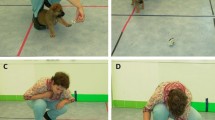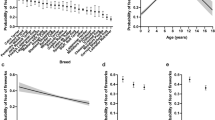Abstract
The present study was performed to investigate the influences of rearing type, time of weaning, and maternal bond on the narcotic detection efficacy of police dogs. One hundred German shepherd dogs (52 males and 48 females) were utilized in this study. The study was divided into three experiments. Experiment I: dogs were divided into two groups with known previous history of rearing system; the first group received natural rearing (natural suckling). While the second group received artificial rearing. Experiment II: dogs were distributed into three groups. In the first group, dogs were weaned at 8 weeks, in the second group, dogs were weaned at 12 weeks and in the third group, dogs were orphans. Experiment III: dogs were distributed into two groups. The first group contained the dogs which were trained in the presence of their mothers, while the second group contained the dogs which were trained in the absence of their mothers. Results revealed that the narcotics detection trainability performance measures were significantly affected by the rearing system, time of weaning as well as the maternal bond, where the naturally reared dogs, dogs weaned at 12 weeks and those trained in the presence of their mothers showed better performance represented by the higher proportions of correct alerts and the lower false alerts, and chances and passes to detect the narcotics. These observations suggests that the events of the past (rearing type, extension of suckling and maternal bond) are correlated to and positively affected the future behavior and narcotic detection efficacy of police dogs without the need for additional reinforcements. In conclusion, this study can be a base for further research toward reducing the expensive and time-consuming training practices required for adult working dogs to locate narcotics and other objectives.
Similar content being viewed by others
Availability of data and materials
All data presented herein are constant with the published literature.
References
Abdel Fattah AF, Abdel-Hamid SE (2020) Influence of gender, neuter status, and training method on police dog narcotics olfaction performance, behaviour and welfare. J Adv Vet Anim Res 7(4):655–662
Abdel Fattah AF, Gharib HAS (2020) Investigation police dog olfactory acuity through: Comparing various dog breeds, previous training experiences and searching site on the detection of narcotics. Adv Anim Vet Sci 8(s2):58–63
Ainsworth, M.D.S.; Blehar, M.C.; Waters, E.; Wall, S.N. Patterns of Attachment: A Psychological Study of theStrange Situation; Psychology Press: New York, NY, USA, 2015.
Baerends-van Roon, J.M., Baerends, G.P., 1979. The morphogenesis of behaviour of the domestic cat. Verhandelingen der Koninklijke Nederlandse Akademie van Wetenschappen, Afd. Natuurkunde, Tweede Reeks, Dee1 72. North-Holland, Amsterdam, pp. l-l 16.
Bales LK (2017) Parenting in animals. Curr Opin Psychol 15:93–98
Bijland L, Bomers M, Smulders Y (2013) Smelling the diagnosis, A review on the use of scent in diagnosing disease. Neth J Med 71:300–307 (PMID: 23956311)
Birnie AK, Taylor JH, Cavanaugh J, French JA (2013) Quality of maternal and paternal care predicts later stress reactivity in the cooperatively-breeding marmoset (Callithrix geoffroyi). Psychoneuroendocrinology 38:3003–3014
Bowlby J (2005) A secure base: clinical applications of attachment theory. Taylor & Francis, Oxfordshire, UK
Bray EE, Sammel MD, Cheney DL, Serpell JA, Seyfarth RM (2017) Effects of maternal investment temperament, and cognition on guide dog success. Proc Natl Acad Sci USA 114:9128–9133
Caldji C, Tannenbaum B, Sharma S, Francis D, Plotsky PM, Meaney MJ (1998) Maternal care during infancy regulates the development of neural systems mediating the expression of fearfulness in the rat. Proc Natl Acad Sci USA 95:5335–5340
Caldji C, Francis D, Sharma S, Plotsky PM, Meaney MJ (2000) The effects of early rearing environment on the development of GABAA and central benzodiazepine receptor levels and novelty-induced fearfulness in the rat. Neuropsychopharmacology 22:219–229
Chesler P (1969) Maternal influence in learning by observation in kittens. Science 166:901–908
Cushing BS, Kramer KM (2005) Mechanisms underlying epigenetic effects of early social experience: the role of neuropeptides and steroids. Neurosci BiobehavRev 29:1089–1105
Czerwinski VH, Smith BP, Hynd PI, Hazel SJ (2016) The influence of maternal care on stress-related behaviors in domestic dogs: What can we learn from the rodent literature? J Vet Behav Clin Appl Res 14:52–59
van Dam A, Schoon A, Wierda SF, Heeringa E, Aaldersa MCG (2019). The use of crime scene detection dogs to locate semen stains on different types of fabric. Forensic Sci. Int. 302: 110201.
Davey G (1981) Animal Learning and Conditioning. Macmillan Education Ltd., London
Dulac C (2014) O’ConnellLA, WuZ. Neural control of maternal and paternal behaviors. Science 345:765–770
Ensminger J (2012). Development of police and military dog functions. In: J. Ensminger Ed.), Police and Military Dogs, CRC Press, Boca Raton, FL, pp. 3–17. https://doi.org/10.1201/b11265.
Flandera V, Novakova V (1974) Effect of the mother on the development of aggressive behaviour in rats. Develop Psychobiol 3:21–26
Foyer P, Wilsson E, Jensen P (2016) Levels of maternal care in dogs affect adult offspring temperament. Sci Rep 6:19253
Foyer P, Bjällerhag N, Wilsson E, et al. Behaviourand experiences of dogs during the first year of lifepredict the outcome in a later temperament test.Appl Anim Behav Sci. 2014;155:93–100.
Gadbois S, Reeve C (2014). Canine olfaction: Scent, sign, and situation. domestic dog cognition and behavior. Springer berlin heidelberg. pp. 3–29. https://doi.org/10.1007/978-3-642-53994-7_1.
Gazit I, Terkel J (2003) Domination of olfaction over vision in explosives detection by dogs. Appl Anim Behav Sci 82:65–73
Guardini G, Mariti C, Bowen J, Fatjó J, Ruzzante S, Martorell A, Sighieri C, Gazzano A (2016) Influence of morning maternal care on the behavioural responses of 8-week-old Beagle puppies to new environmental and social stimuli. Appl Anim Behav Sci 181:137–144
Guardini G 1,* ID , Jon Bowen 2,3, Chiara Mariti1 ID , Jaume Fatjó 3, Claudio Sighieri1and Angelo Gazzano 1. Influence of Maternal Care on Behavioural Development of Domestic Dogs (Canis Familiaris) Living in a Home Environment. Animals 2017, 7, 93; doi:https://doi.org/10.3390/ani7120093.
Gubernick DJ, Klopfer PH (1981) Parental Care in Mammals. Plenum Press, New York
Jantorno GM, Xavier CH, de Melo CB (2020) Narcotic detection dogs: An overview of high-performance animals. Ciência Rural 50(10):e20191010. https://doi.org/10.1590/0103-8478cr20191010
Jezierski T, Walczak M, Go´ recka A, (2008) Information-seeking behaviour of sniffer dogs during match-to-sample training in the scent lineup. Pol Psychol Bull 39(2):71–80
Jezierski T, Adamkiewicz E, Walczak M (2014) Efficacy of drug detection by fully-trained police dogs varies by breed, training level, type of drug and search environment. Forensic Sci Int 237:112–118. https://doi.org/10.1016/j.forsciint.2014.01.013
Johnson, E.O.; Kamilaris, T.C.; Calogero, A.E.; Gold, P.W.; Chrousos, G.P. Effects of early parenting on growthand development in a small primate. Pediatr. Res. 1996, 39, 999–1005. [CrossRef] [PubMed].
Leitch O, Anderson A, Kirkbride KP, Lennard C (2013) Biological organisms as volatile compounds detectors. Forensic Sci Int 232:92–103
Lévy F (2016) Neuroendocrine control of maternal behavior in non-human and human mammals. Annales d’ Endocrinologie 77:114–125
Lit L (2009) Evaluating learning tasks commonly applied in detection dog training. In: Helton W (ed) Canine ergonomics: The science of working dogs. CRC Press, Boca Raton, FL, pp 99–114
Liu D, Diorio J, Tannenbaum B, Caldji C, Francis D, Freedman A, Sharma S, Pearson D, Plotsky PM, Meaney MJ (1997) Maternal care, hippocampal glucocorticoid receptors, and hypothalamic-pituitary-adrenal responses to stress. Science 277:1659–1662
Lorenzo N. , T.L. Wan, R.J. Harper, Y.L. Hsu, M. Chow, S. Rose, K.G. Furton, Laboratory and field experiments used to identify Canis lupus var. familiaris active odor signature chemicals from drugs, explosives, and humans, Anal. Bioanal. Chem. 376 (2003) 1212–1224.
Masís-Calvo, M.; Sequeira-Cordero, A.; Mora-Gallegos, A.; Fornaguera-Trías, J. Behavioral andneurochemical characterization of maternal care effects on juvenile Sprague-Dawley rats. Physiol. Behav.2013, 118, 212–217. [CrossRef] [PubMed].
Meaney MJ (2001) Maternal care, gene expression, and the transmission of individual differences in stress reactivity across generations. Annu Rev Neurosci 24:1161–1192
Mogi K, Nagasawa M, Kikusui T (2011) Developmental consequences and biological significance of mother–infant bonding. Prog Neuropsychopharmacol Biol Psychiatry 35:1232–1241
Mota-Rojas D, Velarde A, Maris-Huertas S, et al., edi-tors. Animal welfare, a global vision in Ibero-America.[Bienestar Animal una visión global en Iberoamérica]. 3rd ed. Barcelona, Spain: Elsevier; 2016.p.516.
Norton-Griffttbs M (1967) Some ecological aspects of the feeding behaviour of the oystercatcher Haematopus ostralegus on the edible mussel, Mytilus edulis. Ibis 109:412–424
Pal SK (2005) Parental care in free-ranging dogs, Canis familiaris. Appl Anim. Behav Sci 90:31–47
Parent CI, Meaney MJ (2008) The influence of natural variations in maternal care on play fighting in the rat Dev. Psychobiol 50:767–776
Rosado SB, Palacio LJ, García BS. Chapter 2. Dogbehaviour and welfare. In: Mota-Rojas D, Velarde A,Huertas-Canén SM, et al., editors. Bienestar animal,una vision global en Iberoamérica [Animal welfare,a global vision in Ibero-America]. 3rd ed. Barcelona:Elsevier; 2016.p.15–40.
Slabbert JM, Anne E (1997) Rasa b, *Observational learning of an acquired maternal behaviour pattern by working dog pups: an alternative training method? Appl Anim Behav Sci 53:309–316
Slabbert JM, Rasa OAE (1993) The effect of early separation from the mother on pups in bonding to humans and pup health. J South Afr Vet Assoc 64:4–8
Zhang TY, Chretien P, Meaney MJ et al (2005) Influence of naturally occurring variations in maternal care on prepulse inhibition of acoustic startle and the medial prefrontal cortical dopamine response to stress in adult rats. J Neurosci 25:1493–1502
Acknowledgements
The authors extend their appreciation to their own University for their support and scientific encouragements.
Funding
This research did not receive any fund.
Author information
Authors and Affiliations
Contributions
AFAF: conceptualization, visualization, methodology, validation, and supervision. ENS: conceptualization, investigation, methodology, software, and data curation. MRF: validation, writing—original draft, formal analysis, and writing—review and editing. All the authors contributed equally to the current research.
Corresponding author
Ethics declarations
Conflict of interest
The authors declare no type of competing interests.
Ethical statement
The handling of the animal in this study followed the guidelines of the institutional animal care and research ethics committee of Zagazig University.
Consent for publication
Not applicable
Consent to participate
Not applicable
Additional information
Publisher's Note
Springer Nature remains neutral with regard to jurisdictional claims in published maps and institutional affiliations.
Rights and permissions
About this article
Cite this article
Fattah, A.F.A., Said, E.N. & Farag, M.R. Narcotic detection efficacy and behavior of police dogs are affected by rearing system, weaning time, and maternal bond. Rend. Fis. Acc. Lincei 33, 185–193 (2022). https://doi.org/10.1007/s12210-021-01041-w
Received:
Accepted:
Published:
Issue Date:
DOI: https://doi.org/10.1007/s12210-021-01041-w




